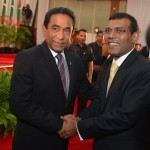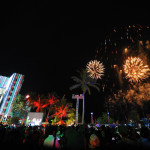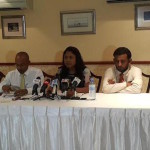Eighteen years ago when Aishath Hassan got pregnant with her third child, little did she know of how her life was about to be completely changed. Six months after the birth of her daughter, Aishath became extremely concerned about the worsening health conditions of her baby.
Worried, she took the baby to a doctor, where she heard the word “Thalassaemia” for the first time.
“The doctor told me my daughter was thalassaemic. Till that day, I did not know what it was or how it had happened. But from that day onwards, my life completely changed,” Aishath, now 45, recollected.
With almost 18 percent of the population registered as carriers, Maldives has the world’s highest incidence of the crippling genetic blood disorder. For those like Aishath’s daughter with Beta Thalassaemia Major, the disease causes severe anaemia and requires lifelong blood transfusions and treatment.
“Screening for thalassaemia, as well as treatment of thalassaemics, is costly but at the moment it’s free in the Maldives. Thalassaemic children require continuous and regular care and treatment to stay alive,” wrote Dr Ibrahim Mustafa, PhD in Pathology and Laboratory Medicine, an important contributor of thalassaemia projects in his blog in January 2012.
“They require monthly transfusions and treatment with the drug Desferrioxamine, injected five times a week. The annual cost of treatment exceeds US$6,000. At present only, Bone Marrow Transplant (BMT) ensures permanent cure for Thalassaemics. But the cost of this treatment ranks between US$30,000 and US$50,000. Due to the low income of average people, this costly treatment BMT cannot be afforded by many families,” he noted.
Currently, 535 patients with thalassaemia major are registered and receive regular blood transfusions at the National Thalassaemia Center (NTC) in the capital Male’. Aishath’s daughter is among them.
The pair visit the centre every two weeks, despite the costly and exhausting four-hour journey from their home island of Thodoo in Alif Alif Atoll.
“It is very tiring and every trip nearly cost nearly Rf3000 as travelling and accommodation prices. We don’t have any other choice,” Aisthath noted.
“On the islands, sometimes blood and medicines such as Desferal (a drug used to moderate iron in the blood of transfused patients) is not available while vital medical treatments charge money. But once we came [to the NTC]almost everything is free. Blood is guaranteed. All services and medicines are available,” she further explained.
Inequalities and financial burdens
 The inequalities in the services available to the thalassamia patients in Male’ and on other islands was noted as a key problem in the statement released by Maldivian Thalassaemia Society (MTS) on the occasion of World Thalassaemia Day, marked on May 8.
The inequalities in the services available to the thalassamia patients in Male’ and on other islands was noted as a key problem in the statement released by Maldivian Thalassaemia Society (MTS) on the occasion of World Thalassaemia Day, marked on May 8.
While the world marks thalassaemia day with the motto “Patients Rights Revisited”, MTS contended that today authorities have “largely neglected” the rights of thalassaemia patients who face numerous challenges to stay alive, especially those in small inhabited islands of the Maldives.
The statement read: “We see huge inequalities in the provision of medical treatments and services to thalassaemia patients living in the islands and services available from the centre established by the government in Male.”
Even though the government has arranged for blood transfusions on the islands, MTS says that for various reasons the service and necessary medications are unavailable, forcing patients to bear high costs of travelling to other nearby islands or to the capital in order to get blood transfusions, without which they will die.
Meanwhile, Program Manager of the Maldives Thalassaemia Society, Imaan Mohamed, noted that the organisation was receiving numerous complaints regarding problems receiving services under the national health insurance scheme, Aasandha.
“We have received several complaints from thalassaemia patients and their parents that hospitals and health centres are charging for medical treatments, including blood transfusions, because they have reached the outpatient coverage limit. But, we were informed during the scheme’s inception that thalassaemia patients would not have the Rf10,000 limit allocated for outpatient services,” Imaan explained.
“So we are discussing with relevant authorities about how to solve this problem, but we have not received a good response,” she added.
Aishath meanwhile called for authorities to make mandatory blood donor tests and other associated treatments free.
“Around Rf1000 is required to test a blood donor,” she said. “That money is deducted from their Aashandha account or we have to pay the donor. So it will be a huge relief if the tests are available for free,” she noted.
The Aasandha Office was not responding at time of press.
“More awareness”
With contributions from the government and NGOs across the country, thalassaemia awareness increased dramatically after 1992 and the word became a household name.
The intitiatives included the Thalassaemia Prevention Program, comprising health education, population screening and genetic counseling by the Society for Health Education (SHE), while in 1993 the National Thalassaemia Program was formulated and in December 1994 the National Thalassaemia Centre inaugurated with a 17 bed ward, blood bank facilities and a diagnostic laboratory service.
Of those screened for thalassemia in 1999, 21.9 percent were carriers, while this rate fell to 18.3 percent in the same period while the number of new thalasaemia cases decreased by almost 50 percent from 43 in 1999, to 24 in 2003.
However, Imaan from the Maldives Thalassaemia Society warned that with “no existing comprehensive national program” to address thalassaemia in the Maldives, the success rates may not be maintained in the future.
“In the past five years, 30 new cases of thalassaemica have been registered while earlier statistics show that the figure was lower,” Imaan observed.
She noted that the Health Ministry’s National Thalassaemia Program, which ended in 2006, included important elements such as population screening, thalassaemia education, prenatal diagnosis and medical termination of pregnancies of foetuses with thalassemia major.
“It is very upsetting that we don’t have a national program now. People need these services and more awareness programs need to be conducted for prevention of Thalassaemia,” Imaan concluded.






I guess this will allow Nasreena to get another $10 million dollars to go shopping in the name of NTS.
Lubna, dont talk of things that you can only guess. think about your ownself.